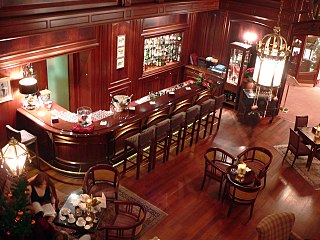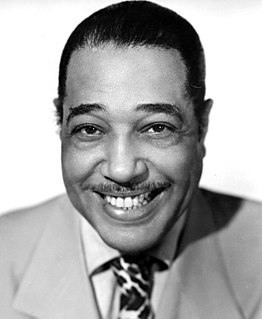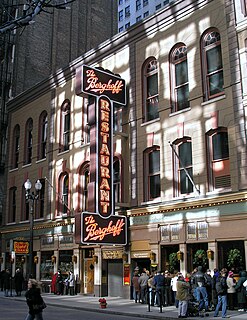
Mary Louise Cecilia "Texas" Guinan was an American actress, producer and entrepreneur. Born in Texas to Irish immigrant parents, Guinan decided at an early age to become an entertainer. After becoming a star on the New York stage, the repercussions of her involvement in a weight loss scam motivated her to switch careers to the film business. Spending several years in California appearing in numerous productions, she eventually formed her own company.

A speakeasy, also called a blind pig or blind tiger, is an illicit establishment that sells alcoholic beverages, or a retro style bar that replicates aspects of historical speakeasies.

The Jazz Age was a period in the 1920s and 1930s in which jazz music and dance styles rapidly gained nationwide popularity in the United States. The Jazz Age's cultural repercussions were primarily felt in the United States, the birthplace of jazz. Originating in New Orleans as mainly sourced from the culture of the diaspora, jazz played a significant part in wider cultural changes in this period, and its influence on popular culture continued long afterwards. The Jazz Age is often referred to in conjunction with the Roaring Twenties, and in the United States, it overlapped in significant cross-cultural ways with the Prohibition Era. The movement was largely affected by the introduction of radios nationwide. During this time, the Jazz Age was intertwined with the developing youth culture. The movement also helped start the beginning of the European Jazz movement.

A bar, also known as a saloon, a tavern or tippling house, or sometimes as a pub or club, is a retail business establishment that serves alcoholic beverages, such as beer, wine, liquor, cocktails, and other beverages such as mineral water and soft drinks. Bars often also sell snack foods, such as crisps or peanuts, for consumption on their premises. Some types of bars, such as pubs, may also serve food from a restaurant menu. The term "bar" refers to the countertop where drinks are prepared and served, and by extension to the overall premises.

The Cotton Club was a New York City nightclub from 1923 to 1940. It was located on 142nd Street and Lenox Avenue (1923–1936), then briefly in the midtown Theater District (1936–1940). The club operated during the United States' era of Prohibition and Jim Crow era racial segregation. Black people initially could not patronize the Cotton Club, but the venue featured many of the most popular black entertainers of the era, including musicians Fletcher Henderson, Duke Ellington, Jimmie Lunceford, Chick Webb, Louis Armstrong, Count Basie, Fats Waller, Willie Bryant; vocalists Adelaide Hall, Ethel Waters, Cab Calloway, Bessie Smith, Aida Ward, Avon Long, the Dandridge Sisters, the Will Vodery Choir, The Mills Brothers, Nina Mae McKinney, Billie Holiday, Lena Horne, and dancers such as Katherine Dunham, Bill Robinson, The Nicholas Brothers, Charles 'Honi' Coles, Leonard Reed, Stepin Fetchit, the Berry Brothers, The Four Step Brothers, Jeni Le Gon and Earl Snakehips Tucker.

A gay bar is a drinking establishment that caters to an exclusively or predominantly lesbian, gay, bisexual, and transgender (LGBT) clientele; the term gay is used as a broadly inclusive concept for LGBTQ+ communities.

A dive bar is typically a small, unglamorous, eclectic, old-style bar with inexpensive drinks, which may feature dim lighting, shabby or dated decor, neon beer signs, packaged beer sales, cash-only service, and a local clientele. That being said, the precise definition of a dive bar is something on which people rarely agree, and is the subject of spirited debates. The term dive was first used in the press in the U.S. in 1880s to describe disreputable places that were often in basements into which one "dives below".

The Levee District was the red-light district of Chicago from the 1880s until 1912, when police raids shut it down. The district, like many frontier town red-light districts, got its name from its proximity to wharves in the city. The Levee district encompassed four blocks in Chicago's South Loop area, between 18th and 22nd streets. It was home to many brothels, saloons, dance halls, and the famed Everleigh Club. Prostitution boomed in the Levee District, and it was not until the Chicago Vice Commission submitted a report on the city's vice districts that it was shut down.

The 21 Club, often simply 21, was a traditional American cuisine restaurant and former prohibition-era speakeasy, located at 21 West 52nd Street in New York City.

The Berghoff restaurant, at 17 West Adams Street, near the center of the Chicago Loop, was opened in 1898 by Herman Joseph Berghoff and has become a Chicago landmark.

El Morocco was a 20th-century Manhattan nightclub frequented by the rich and famous from the 1930s until the decline of café society in the late 1950s. It was famous for its blue zebra-stripe motif and its official photographer, Jerome Zerbe.

The Black Cat Bar or Black Cat Café was a bar in San Francisco, California. It originally opened in 1906 and closed in 1921. The Black Cat re-opened in 1933 and operated for another 30 years. During its second run of operation, it was a hangout for Beats and bohemians but over time began attracting more and more of a gay clientele, and becoming a flashpoint for what was then known as the homophile movement, a precursor to the gay liberation movement that gained momentum in the 1960s.

A drinking establishment is a business whose primary function is the serving of alcoholic beverages for consumption on the premises. Some establishments may also serve food, or have entertainment, but their main purpose is to serve alcoholic beverages. There are different types of drinking establishment ranging from seedy bars or nightclubs, sometimes termed "dive bars", to 5,000 seat beer halls and elegant places of entertainment for the elite. A public house, informally known as a "pub", is an establishment licensed to serve alcoholic drinks for consumption on the premises in countries and regions of British influence. Although the terms are increasingly used to refer to the same thing, there is a difference between pubs, bars, inns, taverns and lounges where alcohol is served commercially. A tavern or pot-house is, loosely, a place of business where people gather to drink alcoholic beverages and, more than likely, also be served food, though not licensed to put up guests. The word derives from the Latin taberna and the Greek ταβέρνα/taverna.
Frank Stephenson was an American saloon keeper and underworld figure in New York City during the mid-to late 19th century. He was the owner of The Black and Tan, a popular Bowery basement bar located on Bleecker Street. It was one of the first saloons to cater to African-Americans and was a competitor against neighboring establishments such as Harry Hill's gambling resort and Billy McGlory's Armory Hall among others. He is also credited for opening the city's first and oldest "undisguised" gay bar, The Slide, also on Bleecker Street.
Barney Josephson (1902–1988) was the founder of Café Society in Greenwich Village, New York's first integrated nightclub. Opening artists in 1938 included Billie Holiday, who first performed the song "Strange Fruit" there.

The Green Mill Cocktail Lounge is an entertainment venue on Broadway in Uptown, Chicago. It is known for its jazz and poetry performances, along with its connections to Chicago mob history.

Terrific Street was a short-lived entertainment district on San Francisco's Barbary Coast during the early 20th century. It consisted of dance halls, jazz clubs, and various kinds of drinking establishments. Terrific Street was centered upon a single block of Pacific Street, which was one of the earliest streets to cut through the hills of San Francisco, starting near Portsmouth Square and continuing east to the first shipping docks at Buena Vista Cove. The district was located between Kearny and Montgomery streets on Pacific Street.

The Green Door Tavern is reputedly Chicago's oldest surviving drinking establishment. It opened in 1921, but the building dates from 1872.
The Casino was a gay and lesbian dance club, café, pool hall, and card room located in Pioneer Square in Seattle. It was opened by Joseph Bellotti in 1930 in the basement of the building where The Double Header was located. It was known as one of the places most welcoming of gays on the West Coast.
















